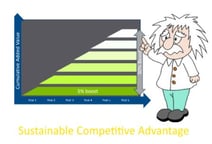The Spreadsheet Paradox: Free to Use, But Costs Millions on Misaligned Projects
Updated:
Published:
I was talking to a PMO the other day. An executive had told him to “Go and fix prioritization. Nothing fancy. Keep it simple.”
Translation: “Just slap a spreadsheet together.”
I’ve lost track of how often I’ve heard this kind of thing, but I’m shocked every time. Why?
- Because it betrays a fundamental misunderstanding of the importance of project prioritization to the delivery of not only projects but also corporate strategy.
- Because project prioritization and resource allocation are one of the most important decisions an organization makes.
- Because it feels a little like the exec, in this case, is handing strategic control of key organizational assets to the PMO!
And spreadsheets simply don’t do a good job of it.
Why prioritize – do things right

Every PMO has heard the saying, “Do the right things, do them right”… and prioritization affects BOTH of those dimensions.
In PMO Land, “Do things right” translates into “Good project execution”. However, many PMO leaders (and executives) don’t fully grasp the importance of prioritization to successful project delivery.
- Weak prioritization often ends in you having too many projects and having too many projects is the best way to ensure your projects are late and over-budget.
- Without clear prioritization, it’s difficult to make clear resource allocation decisions which make it difficult to deliver projects.
- And if the order of prioritization is wrong (see next section), you’re likely to allocate resources to low-value projects at the expense of high-value projects.
I could go on, but the link to prioritization and successful project delivery is very clear. And failing projects cost you money.
Late projects, for example, mean you’re missing out on the benefit of the project for a period of time. Assuming your project is about generating revenue, reducing costs, or similar, this delay directly costs your organization money.
And it’s obvious that over-budget projects are costing you money... because they're over budget!
So, the cost of not getting prioritization right can run into millions of dollars in project overruns and lost business benefits.
Why prioritize - do the right things
Let’s move on to “Do the right things”. In Project Land, that translates into “Pick the best projects”.
Project prioritization is HOW you pick the best projects – “Do the right things” – but not all approaches to prioritization work.
 The internet is full of well-meaning experts who give advice on prioritization that, frankly, is just wrong. There are so many “myths” on how to do prioritization… so let’s not propagate those myths.
The internet is full of well-meaning experts who give advice on prioritization that, frankly, is just wrong. There are so many “myths” on how to do prioritization… so let’s not propagate those myths.
Instead, let’s look at some research into what does work.
The University of New South Wales summarized a couple of decades worth of research into project prioritization and came to the conclusion that most of the common “methods” of prioritizing are simply not suitable.
That includes the magic spreadsheet.
And using these “unsuitable methods of prioritization” are REALLY expensive. According to PMI research, in the typical portfolio of projects, 20% of projects are so badly aligned with the business goals that they should simply be stopped.
20% waste! That’s what the “magic spreadsheet” does for you.
Let’s be clear if you’re spending $10m on your projects, that means you’re wasting $2m every single year. Your spreadsheet is not free, it's costing $2m a year!
That’s one expensive spreadsheet!
The right way to do project prioritization is using something called AHP (Analytic Hierarchy Process) and you can learn why AHP works for prioritization.
Why Prioritize – Opportunity cost
So 20% of projects are waste. What would happen if we could reduce that waste by just 5%?
Well, we’d suddenly be deploying our resources in a way that would deliver more business value. Now, typically, the business value of a project is many times larger than the cost of the project.
So the “value lost” by not doing those value-add projects is many times the cost of the projects…;
 This is, by far, the most serious cost of poor project prioritization. This translates directly into missed business goals and difficulty delivering on the business strategy.
This is, by far, the most serious cost of poor project prioritization. This translates directly into missed business goals and difficulty delivering on the business strategy.
That’s the stuff the exec at the beginning of this blog really, really, really cares about: strategic impact!
I wrote a blog about this a while ago. It’s fun and a little geeky – check it out here.
Opportunity for the PMO Leadership
Now, I don’t really blame the exec. It seems like the obvious thing to do, right? Just slap a spreadsheet together…
…but now you know better.
So this is a chance for you, the PMO leader, to add some value. Part of your role is to identify best practices, and that’s not limited to project implementation templates and reporting.
You have the opportunity to provide some real value by helping your leadership team “discover” that there is best practice in the area of project prioritization (reminder: it’s called AHP).
By learning a little about AHP, you can help walk them through a more value-added project prioritization process.
You can help them pick and better execute the projects that will really deliver their strategic goals!
To help you on this journey, we’ve put together loads of materials.
- Ultimate Guide to Project Prioritization
- These slides will help you clearly set out the cost of poor prioritization
- This blog will help you explain why AHP (and TransparentChoice) is different
